Benefits of AMF on Farms
Key Takeaways
By the end of this module, you should be familiar with:
- the four categories of AMF benefits
- nutrients
- soil
- water
- pests & pathogens
In this module, we are going to do a deep dive into how arbuscular mycorrhizal fungi (AMF) benefit plants in agroecosystems.
AMF are by far the most important mycorrhizae in agricultural ecosystems. They colonize the roots of most crops. The exceptions are some members of the Brassicaceae family and the Amaranthaceae family.
We will divide the benefits AMF offer plants into four broad categories:
- nutrients
- soil
- water
- pests & pathogens
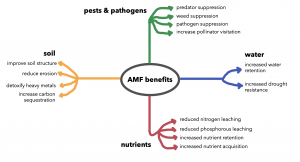
Image 1. AMF Benefit Plants
Nutrients
AMF are best known for their ability to enhance plant nutrient acquisition.
AMF must colonize a living plant root to survive. The basis of all mycorrhizal symbiosis is the exchange of nutrient resources between the plant and fungi. The plant allocates between 10-40 percent of the sugar it created via photosynthesis. In return, the fungi provides the plant with up to 90 percent of its nutritional requirements.
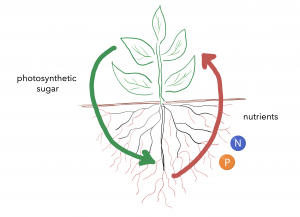
Image 2. Mycorrhizal Symbiosis
The long, thin fungal hyphae act as an extension of a plant’s root system and increase a plant’s access to immobile nutrients. Plant root hairs extend only 1 to 2 millimeters into the soil, while the AMF hyphae extend up to 15 centimeters, scavenging for nutrients in a far greater volume of soil .
AMF are most famous for their ability to provide their plant host with phosphorous. AMF also increase plant acquisition of nitrogen, copper, sulfur, iron, and zinc. AMF can create a nutrient sharing economy between nearby plants. For instance, legumes can share nitrogen through AMF hyphae with neighboring plants.
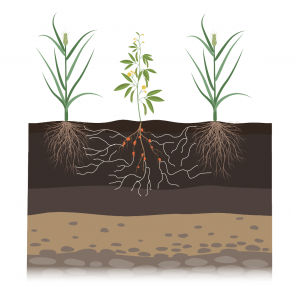
Image 3. Nutrient Sharing Economy
By increasing plant and soil nutrient retention, AMF also decrease nutrient leaching, especially phosphorous and nitrogen leaching.
Increased nutrient acquisition offers many benefits to farmers. Nutrition promotes plant growth and improves plant stress tolerance. By working with AMF, farmers can increase plant nutritional health while decreasing fertilizer input.
Soil
AMF improve soil structure.
These fungi produce a sticky compound called glomalin. This compound acts as a soil superglue and turns soil micro-aggregates into macro-aggregates. Glomalin gives soil good crumb structure.
By improving soil structure, AMF also reduce soil erosion and topsoil loss.
Glomalin is very stable and is a significant contributor to long term soil carbon sequestration. By supporting AMF populations on your farm, you are making your farm more climate-smart.
Glomalin can also bind heavy metals and contributes to the detoxification of heavy metals in soil profiles. AMF are incredible chemists. They can break down complex molecules such as lignin, the molecule that makes plants woody. Due to fungi’s great potential to break down complicated molecules, there is growing interest in mycoremediation – a type of bioremediation that uses fungi to decontaminate the environment.
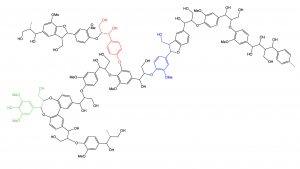
Image 4. Lignin
Water
AMF improve water dynamics on your farm.
By improving soil structure, AMF increase soil and plant water retention, making your crops more resistant to drought. AMF also reduce water runoff after heavy rainfall. As climate change increases the incidence of extreme weather events, AMF emerge as powerful plant allies.
Pests & Pathogens
AMF contribute to pest, pathogen, and weed suppression on farms.
Plants with AMF allies have increased immunity and rigor.
This increased rigor helps plants to outcompete with weeds for resources. It also helps plants resist pests and pathogens.
AMF contribute to predator suppression of herbivores. AMF induce plants to emit chemical compounds (volatile organic compounds) that repel plant herbivores and attract parasitoids. AMF transmit a signal belowground between neighboring plants. If one plant is attacked by herbivores, this belowground signal warns neighbors and they start producing chemical compounds that repel herbivores.
By increasing flower number, size, and nectar production, AMF also indirectly increase pollinator visitation.
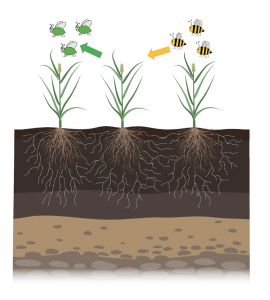
Image 5. AMF Help Plants Repel Herbivores & Attract Pollinators
Informational Handout
link to PDF: benefits of AMF
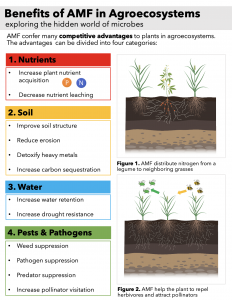
Further Scientific Reading
T. J. Thirkell, M. D. Charters, A. J. Elliott, S. M. Sait, K. J. Field, Are mycorrhizal fungi our sustainable saviours? Considerations for achieving food security. Journal of Ecology 105, 921–929 (2017).
Image Citations
Image 1. AMF Benefit Plants
Alex Lintner. Illustration. April 2019. Attribution CC BY-NC 2.0.
Image 2. Mycorrhizal Symbiosis
Alex Lintner. Illustration. April 2019. Attribution CC BY-NC 2.0.
Image 3. Nutrient Sharing Economy
Alex Lintner. Illustration. BioRender.com. May 2021. Attribution CC BY-NC 2.0.
Image 4. Lignin
Wikimedia Commons. CC BY-SA 3.0.
Image 5. AMF Help Plants Repel Herbivores & Attract Pollinators
Alex Lintner. Illustration. BioRender.com. May 2021. Attribution CC BY-NC 2.0.

